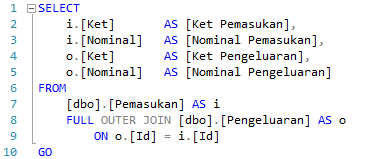
FULL (OUTER) JOIN : Returns all records when there is a match in either left or right table Test Yourself With Exercises. Exercise: Insert the missing parts in the JOIN clause to join the two tables Orders and Customers, using the CustomerID field in both tables as the relationship between the two tables. One of the most powerful features of the T - SQL SELECT statement is the ability to retrieve data from multiple tables using the JOIN clause. Although there are other ways of pulling data from more than one table (e.g., using subqueries, using the APPLY operator), the join is the most commonly used technique. UNION and JOIN within a FROM clause are supported within views and in derived tables and subqueries.
A self- join is a table that is joined to itself. Insert or update operations that are based on a self- join follow the order in the FROM clause. Połączenia typu SELF JOIN to zawsze jedno z już poznanych – INNER, CROSS lub OUTER JOIN, w T-SQL nie stosuje się zapisu SELF JOIN.
EMP firmy X mamy zdefiniowaną referencję pomiedzy kolumnami IdManager i IdPrac. There are four basic types of SQL joins: inner, left, right, and full. The easiest and most intuitive way to explain the difference between these four types is by using a Venn diagram, which shows all possible logical relations between data sets. What is the equivalent of String. Ask Question Asked years, months ago.
Active years, months ago. Possible Duplicate: Is there a way to create a SQL Server function to “join” multiple rows from a subquery into a single delimited field? T-SQL: Deleting all duplicate rows but. Update a table using JOIN in SQL Server?
Join SQL Server tables on a like statement. Can I use CASE statement in a JOIN. APPLIES TO: SQL Server Azure SQL Database Azure SQL Data Warehouse Parallel Data Warehouse. This function returns a string resulting from the concatenation, or joining, of two or more string values in an end-to-end manner.
To add a separating value during concatenation. Note: The INNER JOIN keyword selects all rows from both tables as long as there is a match between the columns. If there are records in the Orders table that do not have matches in Customers, these orders will not be shown! The FULL OUTER JOIN keyword returns all records when there is a match in left (table1) or right (table2) table records.
Note: FULL OUTER JOIN can potentially return very large result-sets! Tip: FULL OUTER JOIN and FULL JOIN are the same. Venn diagrams illustrate the difference in output rows for special cases of inner vs outer join.
I want to update a column in a table making a join on other table e. UPDATE tablea INNER JOIN tableb ON a. I suggest you to go through this link Conditional Joins in SQL Server and T - SQL Case Statement in a JOIN ON Clause. T - SQL use different WHERE clause based on value of input parameter. A JOIN compares columns from two tables, to create result rows composed of columns from two tables. The following are basic rules for combining the result sets of two queries by using UNION : The number and the order of the columns must be the same in all queries.
Twoja przeglądarka nie obsługuje ramek. Today I’ll try to explain how Joins work. If you are a DBA or a T-SQL expert, this is no news to you.
But I’m not, and I’m sure there is a lot of people out there who are in the same situation. For example, sometimes there may be problems and you need to. Hello all, Last week while I was onsite, I was discussing with a customer about some T - SQL querying misconceptions, one particularly caught his interest.
In the subject of JOINs, I was asked if there are there any known issues using search arguments in the ON predicate instead of a WHERE predicate? Writing Outer Joins in T - SQL. Occasionally someone will ask for my help with a query and say that both a right outer join and a left outer join was trie and still the expected were not achieved. That made me realize that some developers do not completely understand. SQL Joins with On or Using I recently wrote a post about inner and outer joins , and a couple of people asked what the difference is between USING and ON.
SQL Server (Transact- SQL ) JOINS are used to retrieve data from multiple tables. In a nutshell, you use ON for most things, but USING is a handy shorthand for the situation where the column names are the same. In SQL Server, NOT EXISTS and NOT IN predicates are the best way to search for missing values, as long as both columns in question are NOT NULL. JOIN 来从两个表中获取数据。 如果我们希望列出所有人的定购,可以使用下面的 SELECT 语句: SELECT Persons.
OrderNo FROM Persons INNER JOIN Orders ON Persons.
Brak komentarzy:
Prześlij komentarz
Uwaga: tylko uczestnik tego bloga może przesyłać komentarze.